- 2 Introduction
- 2.1 Health and Wellbeing
-
2.2 Biodiversity
- 2.3 Climate Change Adaption
- 3 Design
- 3.1 Public Open Space
- 3.1.1 - Location
- 3.1.2 - Layout
- 3.1.3 - Accessibility
- 3.1.4 - Boundary Treatment
- 3.1.5 - Planting
- 3.1.6 - Play
- 3.2 SUDS
- 3.3 Green Corridors and Connections
- 3.4 Private Amenity Space
- 3.4.1 - Older Persons Accommodation and Supported Living
- 3.5 Management & Maintenance
- 4 Design Checklist
- 5 Policy & Guidance
- 5.1 National Planning Policy Framework
- 5.2 National Design Guide
- 5.3 National Model Design Code
- 5.4 25 Year Environment Plan - HM Government
- 5.5 20 Minute Neighbourhoods - TCPA
- 5.6 Homes for People and Wildlife - The Wildlife Trusts
- 5.7 Accessible Natural Greenspace Standards - Natural England
- 5.8 Guidance for Outdoor Sport and Play - Fields in Trust
- 5.9 Design for Play - Play England
- 5.10 Accessibility
- 5.11 Safer Parks: Improving Access for Women and Girls - WYCA & UOL
- 5.12 Happi Report - Homes & Communities Agency
- 5.13 Leeds City Council Core Strategy
- 5.14 Leeds City Council Our Spaces Strategy
- Endnotes
Introduction
This guidance underpins national policy and guidance (National Planning Policy Framework, National Design Guide, National Model Design Code) and local policy, primarily Core Strategy 2019 (as Amended) Policy G4 and Policy G5. It covers design and management requirements for quality green spaces in new developments comprising:
- Public open space
- Play
- Natural green space
- SUDS
- Green corridors and connections
- Private amenity space including balconies, communal gardens, roof gardens
It is intended for use by Developers, Landscape Architects, Urban Designers, Architects and place-makers, as well as Planning Officers.
2.1 Health and Wellbeing
Green spaces benefit health and wellbeing by providing pleasant and safe space for physical activity including play, improving air quality and boosting mental health through access to nature (how connecting with nature benefits our mental health by Mental Health Foundation 2021). Close proximity to accessible green spaces is key to experiencing these benefits and so perceived and actual barriers to access must be designed out (Out of Bounds – Equity in Access to Urban Nature by Groundwork 2021 and Improving access to greenspace by Public Health England 2020). Green spaces have proved to be an essential health resource in coping with the COVID-19 pandemic (The role of perceived public and private green space in subjective health and wellbeing during and after the first peak of the COVID-19 outbreak study by Poortinga et al (Cardiff University) 2021) and being within a 5 minute walk of a park or significant green space has been found to be the strongest predictor of satisfaction within neighbourhoods(Home Comforts During The Covid-19 Lockdown study by Place Alliance 2020).
2.2 Biodiversity
Natural green spaces with high levels of biodiversity increase benefits to mental health and wellbeing (Not All Green Space Is Created Equal: Biodiversity Predicts Psychological Restorative Benefits From Urban Green Space study by Wood et al University of Leeds & Bradford Teaching Hospitals NHS Foundation Trust) 2018) as well as providing valuable habitats. Green spaces play a key role in achieving biodiversity net gain which is required by Core Strategy Policy G9 and can take the form of small nature reserves and connected biodiverse planting as part of a network of green infrastructure across all development sites and connecting to the local area.
2.3 Climate change adaption
Providing habitats for wildlife is part of how green spaces can support climate change adaption, alongside planting and ponds for carbon sequestration (High carbon burial rates by small ponds in the landscape study by Taylor et al Northumbria University 2019), shade and cooling (cooling effect of urban parks and their relationship with urban heat islands study by Yang et al 2016) and rainfall absorption (the effect of green spaces and urban trees on reducing flood risk study by Earthwatch Europe 2020). Public and private green spaces can also be used for small-scale food production which increases the resilience of communities.
3 Design
Design of quality green spaces should be approached in a strategic, comprehensive manner, beginning with retaining existing green infrastructure features (trees and woodlands, hedgerows, meadows and wetlands) in the overall layout, and then enhancing and connecting the existing through public open space, linear routes and private amenity space (NPPF, NDG, 20mN, HfP&W).
3.1 Public Open Space
The total size and types of public open space (POS) provided on site shall meet the requirements of Core Strategy 2019 (As Amended) Policy G4, Policy G5. They should also be designed with regard to Natural England Accessible Natural Greenspace Standards and Fields in Trust Guidance for Outdoor Sport and Recreation which are detailed in the Policy & Guidance section.
3.1.1 Location
Public open space must be provided on-site for the benefit of all residents in the local community (25yEP). In the city centre, public open spaces also benefit visitors to the city and play a role in delivering Leeds City Council’s vision for the creation of vibrant, inclusive and world-class city centre public realm (OSS). Everyone should have equal access across the development and so public open space shall be located centrally with safe pedestrian routes from all homes. On large sites, it may be appropriate to provide a hierarchy of public open spaces comprising a central large space and a series of smaller neighbourhood and doorstep spaces throughout the development, connected by green routes (NDG, NMDC).
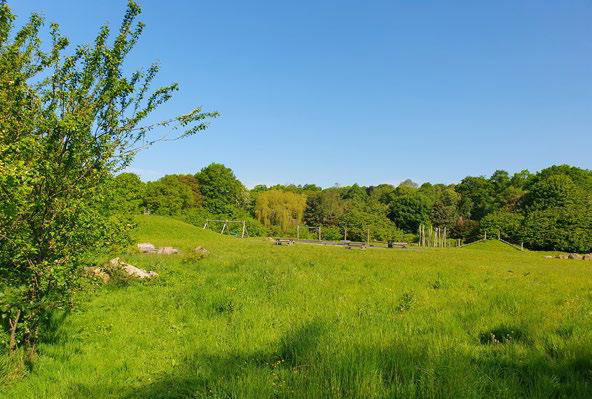
Central large public open space at Moortown Park
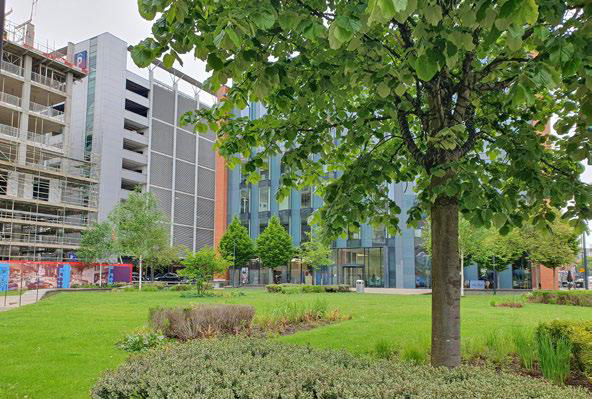
Medium city centre public open space at Sovereign Square
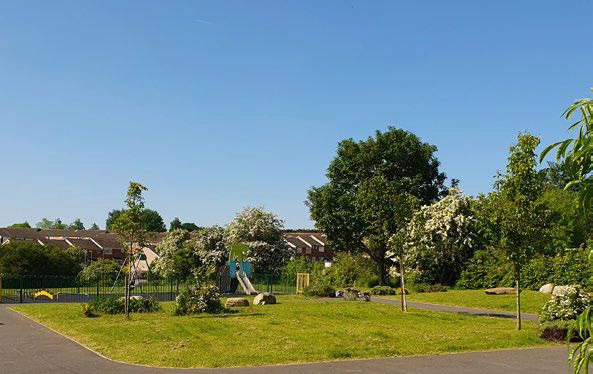
Medium public open space at Alder Road, Grimes Dyke
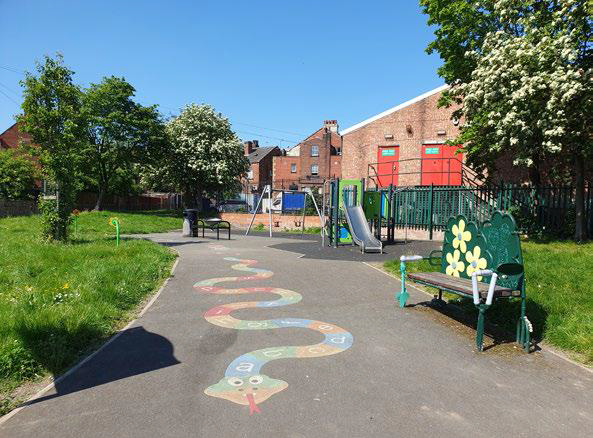
Doorstep public open space/pocket park at Garnets Pocket Park
Active frontages and pedestrian and cycle routes shall be arranged around public open space to allow natural surveillance of the space (Safer Parks).
The arrangement of public open space must not be territorial, residents should feel welcome to visit all the green spaces in their local area and beyond. This can be achieved through clear connections and a good balance between natural surveillance for safety and spaces being so overlooked that they appear to be for residents only (NDG, OSS).
See Green corridors and connections section below.
3.1.2 Layout
Public open spaces must be usable for recreation including moving, playing, resting and observing nature (NDG, NMDC, Safer Parks, OSS). Narrow strips, exclusively linear spaces, pieces of woodland and isolated ‘leftover’ areas which are not well overlooked or easy to access are not suitable as public open spaces and will not be counted towards the overall provision in accordance with the Local Plan policies; although may have value as other types of green space such as green corridors and connections, and can contribute to distinctive placemaking.
Sensitive nature areas as part of public open spaces may require design to minimise disturbance such as fencing and careful siting of footpaths. Interpretation panels can be used to explain the management arrangements and key features.
The arrangement of features within the public open space should consider adjacent connections, dwellings and land uses, for example by including a planted buffer with trees and shrubs between dwellings and activity/social spaces to maintain privacy.
3.1.3 Accessibility
It is essential that green spaces are designed and managed to be inclusive of everyone’s accessibility and safety needs (NPPF, NDG, OSS, Safer Parks), for example by providing low traffic green routes to green spaces, natural surveillance and clear routes through spaces, accessible entrances, seats, and regular maintenance of equipment and litter picking.
The arrangement of streets around green spaces must be carefully designed to slow traffic and allow safe access for everyone including children. For example, green spaces adjacent to major or Connector streets may require formal pedestrian crossings and buffer measures at entrances such as verges and staggered barriers to slow egress; green spaces adjacent to quieter streets such as Local Residential, Shared Space and city centre service access may require informal measures to emphasise crossings and slow traffic such as contrasting road surfacing, raised tables, carriageway narrowing. Engagement with Highway Engineers at an early stage is recommended to design good quality and safe access to green spaces in accordance with Leeds City Council Transport SPD.
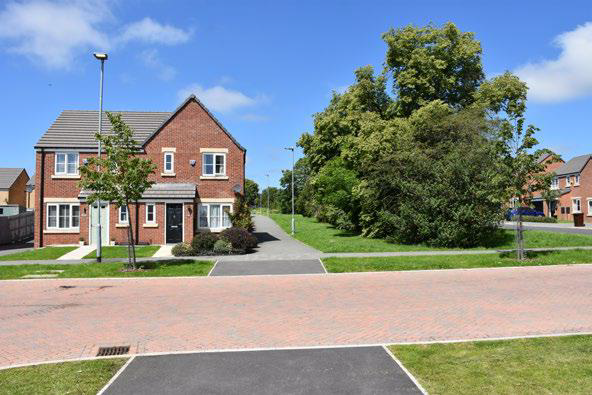
Paved raised table to slow traffic and provide level access across the carriageway for pedestrians at Grimes Dyke. Note existing trees retained providing instant maturity to the development.
All green spaces must be physically accessible for all. Paths must be hard surfaced and wide enough for their intended use:
Strategic pedestrian and cycle routes to and through green spaces must be designed in accordance with Leeds City Council Transport SPD:
- Footpaths: minimum 2m, or minimum 3m in areas of identifiably higher
- levels of pedestrian activity e.g. city centre, adjacent to schools, shops, bus stops etc.
- Cycleways: one-way minimum 2m, two-way minimum 3m
- Shared footpath and cycleway: minimum 3m
Informal recreational pedestrian routes around green spaces: minimum 2m, or minimum 1.5m if passing places are provided (Accessible Leeds Supplementary Planning Document by Leeds City Council 2016). Circular path systems are required on all green spaces. These bring multiple benefits including health and wellbeing as well as security for users.
Seating shall be provided throughout green spaces, particularly to provide places to rest and appreciate views along paths and for carers to supervise children in play areas. Seats shall provide a variety of options with and without armrests and backrests, and with inset armrests for wheelchair transfer. Seats shall be set back from paths on hard surfacing.
See Accessibility section in Policy & Guidance for further guidance.
3.1.4 Boundary Treatment
Public open space boundaries shall be defined appropriately for the setting using boundary treatments, planting, hard surface material changes, with clear access points to ensure spaces feel safe and legible for all users (NMDC, Safer Parks).
In the city centre and busy pedestrian areas, public open spaces may require Hostile Vehicle Mitigation (HVM) measures as part of the boundary treatment. HVM shall be designed in accordance with current best practice.
Planting as part of the boundary treatment softens edges, maximises biodiversity value and disperses pollution - evergreen species with small leaves are most beneficial to air quality (Designing vegetation barriers for urban air pollution abatement: a practical review for appropriate plant species selection study by Barwise & Kumar (Global Centre for Clean Air Research) 2020). If hedging is proposed to secure a boundary, it will be necessary to provide railings in addition to hedging unless there is an existing established hedge.
Gated access points shall be accessible gates/barriers.
3.1.5 Planting
A variety of connected planting and seasonal interest is required in all public open spaces from bulbs to shrubs, trees, hedges and, if appropriate, fruit trees and naturalistic native type mass planting (NPPF, NDG, OSS). This variety and connectedness is required for reasons of aesthetics, placemaking and the provision of biodiversity net gain. Plant selections must consider resilience to expected climate changes including hotter summers and wetter winters.
Earth mounding features could be included in combination with planting for visual interest as well as opportunities for sunbathing and informal play. Any mounding must have free flowing, natural contours and not look engineered.
Flat lawn areas shall be provided for informal games and community gatherings where there is sufficient space for these uses. Very small areas of grass are maintenance intensive and have very limited usability and biodiversity value.
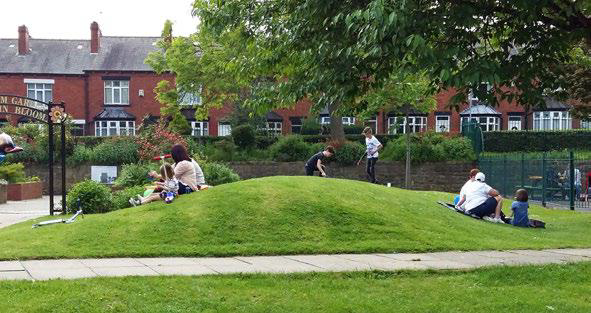
Earth mounding with free flowing, natural contours at Cross Flatts Park, Beeston
3.1.6 Play
All public open spaces shall include some form of play provision (NDG, OSS) if children live nearby or are expected to visit.
Fields in Trust Guidance for Outdoor Sport and Recreation is used to inform the scope of play (NMDC), including catchments, the quantities required (based on the number of dwellings) and minimum sizes and dimensions for each type of play. 5.8 Guidance for Outdoor Sport and Play - Fields in Trust.
The different play types include:
- LAPs (Local Areas for Play) aimed at very young children. Play shall provide for at least 3 different inclusive play experiences The full requirement details can be found under this (LAP detail)
- LEAPs (Locally Equipped Areas for Play) aimed at children who can go out to play independently. Play shall provide for at least 6 different inclusive play experiences. The full requirement details can be found under (LEAP detail)
- NEAPs (Neighbourhood Equipped Areas for Play) aimed at older children. Comprising an area for play equipment and structures & a hard surfaced area of at least 465sqm. The full requirement details can be found under (NEAP detail)
Play equipment and features aimed at older children (8+ years old) including teenage girls are also encouraged, these provide more challenging and enriching experiences for younger children as well as providing for older children (DfP, Safer Parks).
Boundary treatments are necessary around play areas to ensure separation from roads, cycleways, which represent a major health and injury hazard. The boundary treatment shall not tightly surround the play equipment and allow play to extend in to open and natural areas (DfP). Potential issues with dog walkers can be resolved by good management such as dogs are always on leads.
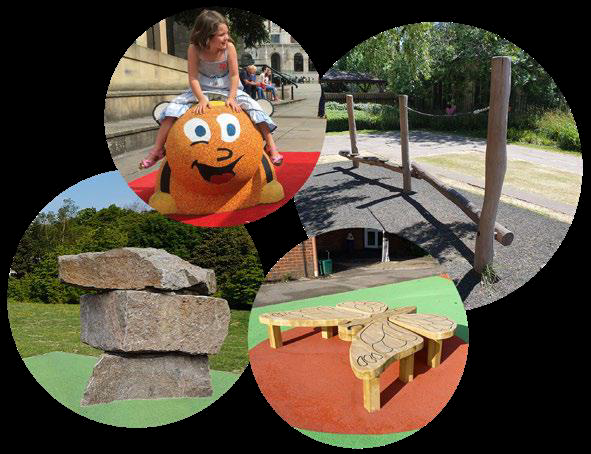
Example features for Local Area for Play (LAP) (butterfly sculpture photo courtesy of designer & supplier: Hand Made Places)
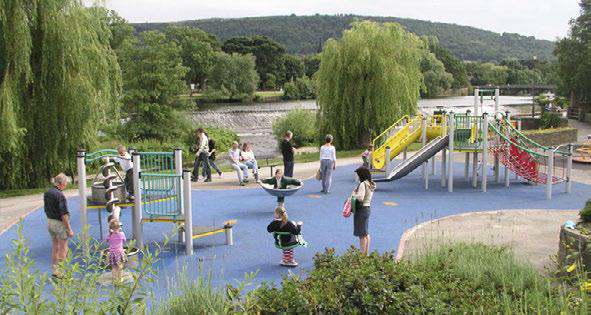
Picture of an inclusive Locally Equipped Area for Play (LEAP) at Wharfemeadows Park, Otley (photo courtesy of designer & supplier: Sutcliffe Play)
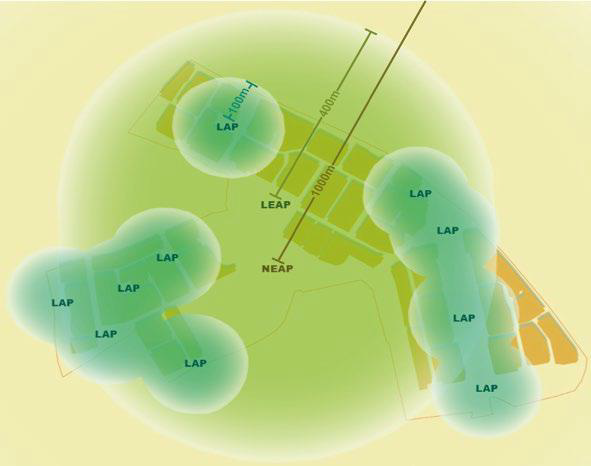
Example site plan showing LAPs, LEAP, NEAP, walking distance radiuses and residential blocks
3.2 SUDS
Sustainable Urban Drainage Systems can form positive elements of public open space and green infrastructure if the right systems are designed-in at an early stage (Pre-Application Stage or before) (NDG, NMDC, OSS). The CIRIA SUDS Manual13 sets out ‘four pillars’ or design objective of SUDS where surface water runoff is managed for water quantity, water quality, amenity and biodiversity benefits.
Open water/green SUDS in the form of retention ponds, rain gardens, swales, and tree pits which manage water quantity and quality while providing amenity and biodiversity benefits, should be the first choice ahead of underground apparatus such as tanks with restrictive easements which preclude planting of the ground above and can also require above-ground apparatus such as pumping stations, access chambers etc. Underground systems also require a large amount of concrete or plastic to be buried underground which is not acceptable in the context of the climate emergency due the high carbon footprint of these materials.
The management and maintenance of open water/green SUDS is often part of the regular landscape management.
See Management & Maintenance section for further guidance.
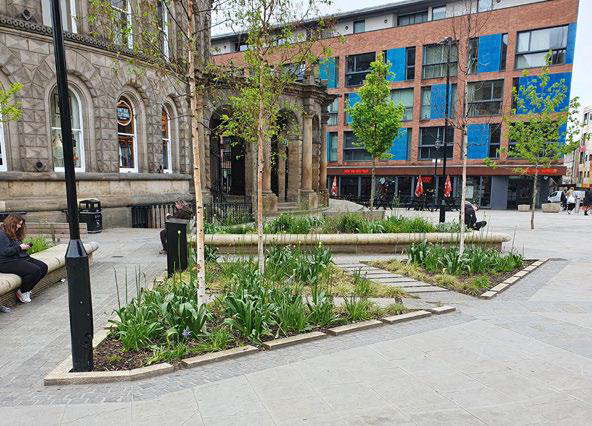
Rain garden at Corn Exchange
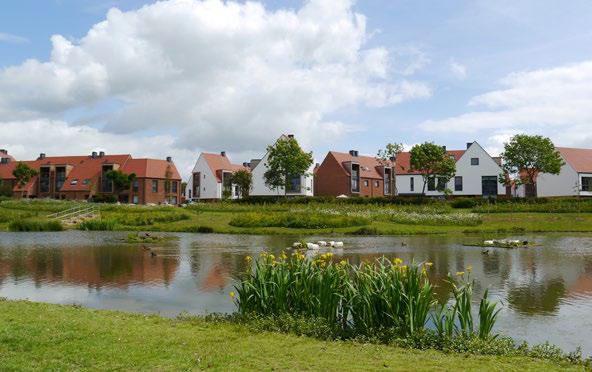
SUDS at Derwenthorpe, York (photo courtesy of architect: Studio Partington
3.3 Green Corridors and Connections
Green corridors and connections use existing and new green infrastructure to create safe and attractive links for people and wildlife, segregated from vehicular traffic.
All developments including employment sites shall retain existing green infrastructure and connect to adjacent existing green infrastructure for amenity and biodiversity value.
Key connections to green spaces, public rights of way and amenities including safe routes to school shall be green links where everyone can walk, cycle and wheel along a green route.
Green corridors and connections primarily take the form of linear parks and woodlands, planted verges, hedgerows, and street tree avenues as a minimum, and are distinct from public open open spaces (NPPF, NMDC, 20mN). Linear parks are expected to be minimum 20m wide and to follow the green space principles for location, accessibility, boundary treatment, planting, East Leeds Extension Development Framework SPD includes good design principles for ‘greenways’ in residential neighbourhoods. New streets shall be tree-lined (NPPF) and Connector and Local Residential streets shall incorporate minimum 3m wide verges with trees and shrubs in accordance with Leeds City Council Transport SPD.
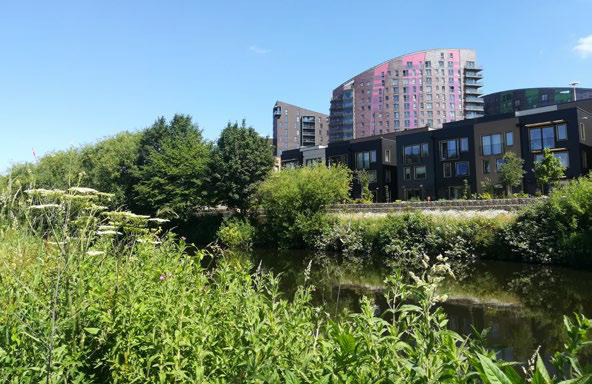
River Aire city centre green corridor
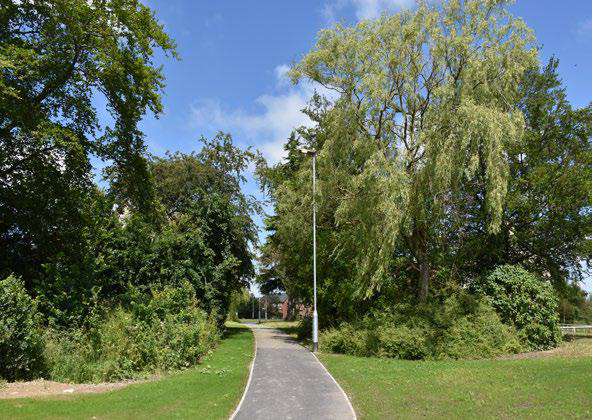
Green route through a linear park at Grimes Dyke
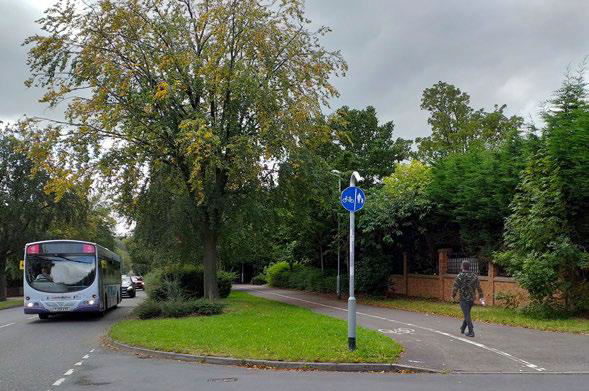
Pedestrian and cycle route segregated from vehicular traffic by planted verge with shrubs and trees in Meanwood
3.4 Private Amenity Space
Private amenity space is vital for the wellbeing of residents and should be provided for all types and tenures of dwelling including flats in the form of traditional private gardens, communal gardens, roof gardens and balconies. It must be easily accessed from dwellings and usable, so narrow strips and isolated ‘leftover’ areas are not suitable as amenity space.
Leeds City Council Neighbourhoods for Living SPD should be used to inform private amenity space design:
- Private gardens for family homes should have a minimum area of 2/3 of total gross floor area
- Communal areas for higher density developments such as flats can be reduced to one quarter of total gross floor area
- Private amenity space should not be overshadowed by trees and buildings, directly overlooked, steeply sloping, awkwardly shaped or very narrow
Balconies should be provided as vital private amenity space for homes above ground floor-level, including tall buildings, subject to wind assessments for safety and comfort.
Communal gardens shall be located to maximise sunlight, provide equitable access for all tenures and privacy and separation from private living areas, public spaces, building servicing and bin stores. Quality amenity features shall be provided to suit the intended residents, usually at least a variety of planting and seating, with play features provided where children are expected to be residents or visitors.
Roof gardens and amenity spaces at podium level should include a range of planting including trees and must be structurally designed to accommodate adequate soil depths. Medium-large trees require at least 1-2m soil depth and soil volumes should be informed by Leeds City Council Urban Tree Planting guidance. Areas of unplanted raised beds approximately 1.2m wide with at least 600mm soil depth are welcomed to support residents gardening and growing food (20mN). See Green Roof Organisation Green Roof Code . An irrigation system will be required, designed in accordance with BS7562-3:1995 Planning, design and installation of irrigation schemes (Part 3: Guide to irrigation water requirements) and BS8545 2014 Trees from Nursery to Independence.
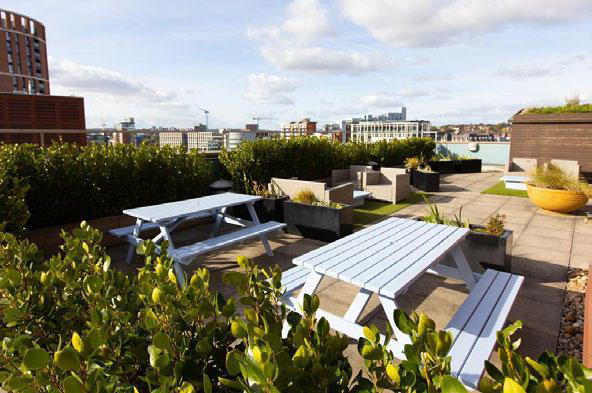
Communal roof garden at Watermans Place
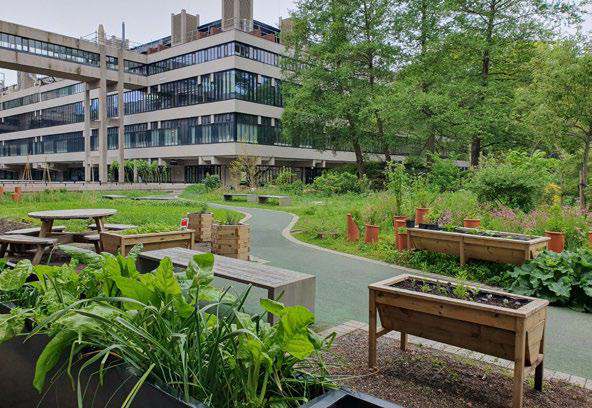
Podium amenity space at University of Leeds Sustainable Garden
3.4.1 Older Persons Accommodation and Supported Living
Private amenity space within grounds can be hugely beneficial for residents’ mental and physical health. Older persons accommodation and supported living developments are usually higher density and so communal outdoor areas should total ¼ gross floor area, as set out in Leeds City Council Neighbourhoods for Living SPD.
A circular walk segregated from vehicular traffic should be provided within the grounds, with a path wide enough to accommodate two people or two wheelchairs side by side and of an accessible gradient. Paving materials shall be paved or a bound material and non-slip and non-glare. Seating which incorporates backrests, armrests and wheelchair transfer spaces shall be provided which allow all residents and visitors to rest together.
A range of planting with seasonal variety shall be provided throughout the grounds. Species selections for supported living developments shall avoid toxic, thorny plants or species with serrated leaves and plants with any bright berries or inedible fruits shall be located out of reach. Areas of unplanted raised beds approximately 1.2m wide with at least 600mm soil depth and storage space for tools are welcomed to support residents gardening and growing food (20mN).
Outdoor patios connected to communal dining and social areas, as well as private patios for ground floor bedrooms are encouraged to allow residents to spend more time outdoors. Patios and buffer planting adjacent to ground floor bedrooms also provide privacy for residents.
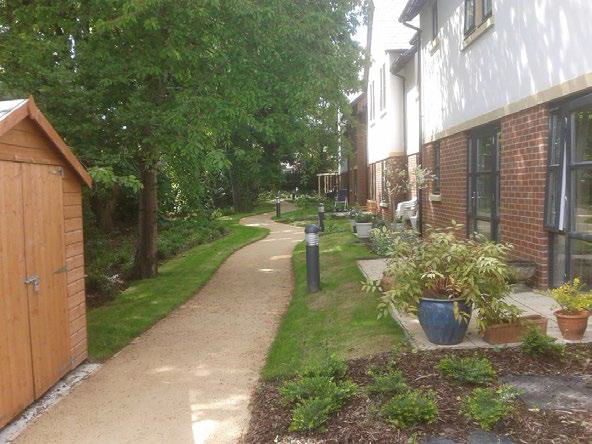
Circular walk with lighting and resident patios at Victoria Park, Headingley
3.5 Management and maintenance
Green spaces should be well managed and maintained throughout the lifetime of the development for the enjoyment of residents and biodiversity value.
Varied mowing regimes are encouraged to maintain essential mown areas for games with longer grass for biodiversity value.
Sensitive nature areas such as wildflower meadows/species rich grass are challenging to maintain correctly and have a high failure rate. A specialist management company should be brought in during the design process to ensure long term success of nature areas.
Management and maintenance of open water/green SUDS should be considered early in the design process and is often part of the regular landscape management, such as litter picking, grass cutting and inspection of components. Less frequent maintenance tasks include silt control, vegetation management and repairs as required.
See Leeds City Council Landscape Management Plans guidance.
Design Checklist
Are all the quality green spaces design and management requirements considered in the new development?:
Public open space
| 1. Size and types meet Core Strategy policies G4 & G5 (3.1) | |
| 2. Default on-site provision (3.1.1) | |
| 3. Centrally located main POS (3.1.1) | |
| 4. Natural surveillance from active frontages and routes (3.1.1) | |
| 5. Useable for recreation (3.1.2) | |
| 6. Highway features designed for safe access (3.1.3) | |
| 7. Inclusive of everyone’s accessibility and safety needs (3.1.3) | |
| 8. Open water/green SUDS used (3.2) | |
| 9. Green infrastructure retained and connected (3.3) | |
| 10. Key pedestrian and cycle connections are green routes (3.3) | |
| 11. Paths hard surfaced and wide enough for intended use (3.1.3) | |
| 12. Seating provided (3.1.3) | |
| 13. Boundary treatments appropriate for setting (3.1.4) | |
| 14. Varied planting from bulbs to shrubs, trees, hedges (3.1.5) | |
| 15. Lawn areas large enough for informal games and community gatherings (3.1.5) | |
| 16. Play features/equipment provided (if children live nearby or are expected to visit) (3.1.6) |
Private Amenity Space
| 17. Provided for all dwellings (3.4) | |
| 18. Size and types meet Neighbourhoods for Living SPD (3.4) | |
| 19. Balconies considered for dwellings above ground level (3.4) | |
| 20. Roof and podium gardens structurally designed to accommodate adequate soil depths and volumes for trees (3.4) | |
| 21. Communal gardens are accessible and useable with planting, seating, play to suit intended residents (3.4) |
Management and maintenance
| 22. Landscape Management Plan (3.5) |
Policy & Guidance
The provision of good quality local green spaces which are attractive, accessible and feel safe with natural features and play opportunities is supported by national and local policy and guidance:
5.1 National Planning Policy Framework
The NPPF advocates a presumption in favour of sustainable development and identifies the three dimensions of sustainable development as economic, social and environmental. Access to well-designed, high quality open spaces and opportunities for sport and recreation are highlighted as an important aspect of healthy communities.
One of the core planning principles for developments is to “create places that are safe, inclusive and accessible and which promote health and well-being, with a high standard of amenity for existing and future users” (130).
Trees are identified as important elements of placemaking throughout developments: “ensure that new streets are tree-lined, that opportunities are taken to incorporate trees elsewhere in developments (such as parks and community orchards), that appropriate measures are in place to secure the long-term maintenance of newly planted trees, and that existing trees are retained wherever possible.” (131)
5.2 National Design Guide
The National Design Guide is part of the government’s collection of planning practice guidance and as such can be used as a material consideration in planning decisions. The guidance sets out that developments should:
- "integrate existing, and incorporate new natural features into a multifunctional network that supports quality of place, biodiversity and water management, and addresses climate change mitigation and resilience
- prioritise nature so that diverse ecosystems can flourish to ensure a healthy natural environment that supports and enhances biodiversity
- provide attractive open spaces in locations that are easy to access, with activities for all to enjoy, such as play, food production, recreation and sport, so as to encourage physical activity and promote health, well-being and social inclusion" (91).
- “include well-located public spaces that support a wide variety of activities and encourage social interaction, to promote health, well-being, social and civic inclusion;
- have a hierarchy of spaces that range from large and strategic to small and local spaces, including parks, squares, greens and pocket parks;
- have public spaces that feel safe, secure and attractive for all to use; and
- have trees and other planting within public spaces for people to enjoy, whilst also providing shading, and air quality and climate change mitigation.” (100)
These principles are supported by several policies in the National Design Guide:
- Policy N1: Provide a network of high quality, green open spaces with a variety of landscapes and activities, including play
- Policy N2: Improve and enhance water management “water features form part of an integrated system of landscape, biodiversity and drainage… they also enhance the attractiveness of open spaces and provide opportunities for play, interaction and relaxation.”
- Policy N3: Support rich and varied biodiversity
- Policy P1: Create well-located, high quality and attractive public spaces “designed to support an active life for everyone” “accessible to all and designed to meet the needs of their most vulnerable users” “include natural elements such as tree planting or water.”
- Policy P2: Provide well-designed spaces that are safe
- Policy P3: Make sure public spaces support social interaction “sited so that it is open and accessible to all local communities”
- Policy M1: A connected network of routes for all modes of transport Streets as public spaces and connections between green spaces
5.3 National Model Design Code
The National Model Design Code is part of the government’s collection of planning practice guidance and as such can be used as a material consideration in planning decisions. The code states that “Nature and green spaces should be woven into the fabric of our villages, towns and cities. This provides benefits in terms of health and wellbeing, biodiversity, climate and food mitigation.” (51 )
Green spaces should be multi-functional and part of a network and the code references provision standards including Fields in Trust (60 ).
The design of open spaces should consider 8 key aspects: boundary, entrances, surveillance, activity, maintenance, ecology, access, lighting and integrate SUDS (51 ).
5.4 25 Year Environment Plan - HM Government
Target to enhance beauty, heritage and engagement with the natural environment, in part by “making sure that there are high quality, accessible, natural spaces close to where people live and work, particularly in urban areas, and encouraging more people to spend time in them to benefit their health and wellbeing.” (Target 6 )
5.5 20-Minute Neighbourhoods - TCPA
Good green spaces in the right places “that offer a variety of landscapes and activities, including play” is a key feature of 20-minute neighbourhoods and the guidance states that new large-scale developments should be landscape-led to ensure “that the green infrastructure on the site is assessed, and its multiple functions understood, so that the new development protects important green infrastructure assets, enhances the green infrastructure already on the site, and connects with wider green and blue networks.” (2.4 )
Local food production is another key feature of 20-minute neighbourhoods and the guidance states that new large-scale developments should “optimise the design opportunities for people to grow food in allotments, smallholdings and community gardens, parks, and other sites – as well as in homes and around, inside and on top of buildings through the creative use of spaces such as roofs, walls, and balconies.” (2.5 )
5.6 Homes for People and Wildlife - The Wildlife Trusts
This guidance sets out how to build housing in a nature-friendly way so that all developments result in a measurable improvement for wild species and habitats, and natural green spaces are close to homes and mostly accessible to people.
The approach begins by retaining existing meadows, wetlands, hedgerows, trees and woods which are then connected to gardens, verges, amenity green space, cycle paths and walkways.
5.7 Accessible Natural Greenspace Standards - Natural England
The Accessible Natural Greenspace Standards (ANGSt) “provide benchmarks for assessing the provision of places where people can experience and enjoy nature” and aim to improve the naturalness of green spaces and, access and connectivity to them.
ANGSt recommends that everyone, wherever they live, should have an accessible natural greenspace:
- of at least 2 hectares in size, no more than 300 metres (5 minutes walk) from home;
- at least one accessible 20 hectare site within two kilometres of home;
- one accessible 100 hectare site within five kilometres of home; and
- one accessible 500 hectare site within ten kilometres of home; plus
- a minimum of one hectare of statutory Local Nature Reserves per thousand population (1.2 )
Because ANGSt takes a broad view of what constitutes natural greenspace, the requirements can be met through a wide range of different types of space, from local parks, greenways and footpaths, areas set aside for sustainable urban drainage systems, woodland and heathland. The 300 metre and 2 km standards are valuable standards to apply for new housing developments, growth areas, and in the master planning process.
5.8 Guidance for Outdoor Sport and Play - Fields in Trust
The Outdoor Sport and Play guidance aims to “ensure that the provision of outdoor sport, play and informal open space is of a sufficient size to enable effective use; is located in an accessible location and in close proximity to dwellings; and of a quality to maintain longevity and to encourage its continued use.”
5.8.1 Benchmark Guidelines:
| Open space typology | Quantity guideline (hectares per 1,000 population) | Walking guideline (walking distance: metres from dwellings) |
|---|---|---|
| Equipped/designated play areas | 0.25 | LAPs - 100m LEAPs - 400m NEAPs - 1,000m |
| Other outdoor provision (MUGAs and skateboard parks) | 0.30 | 700m |
5.8.2 Application of Quantity Guidelines:
| Scale of Development | LAP - Local Area for Play aimed at very young children | LEAP - Locally Equipped Areas for Play aimed at children who can go out to play independently | NEAP - Neighbourhood Equipped Areas for Play aimed at older children | MUGA - Multi Use Games Area |
|---|---|---|---|---|
| 5-10 dwellings | / | |||
| 10-200 dwellings | / | / | Contribution | |
| 201-500 dwellings | / | / | Contribution | / |
| 501+ dwellings | / | / | / | / |
Note: for the purposes of these guidelines, two and three bedroom apartments will fall within the definition of a “dwelling” (see below for City Centre situations.
5.8.3 Minimum Sizes:
| Open space typology | Minimum sizes (hectares) | Minimum dimensions (metres) | Buffer zones |
|---|---|---|---|
| LAP | 0.01 | 10 x 10 (minimum activity zone of 100sqm) | 5m minimum separation between activity zone and the boundary of dwellings |
| LEAP | 0.04 | 20 x 20 (minimum activity zone of 400sqm) | 20m minimum separation between activity zone and the habitable room facade of dwellings |
| NEAP | 0.1 | 31.6 x 31.6 (minimum activity zone of 1,000sqm comprising an area for play equipment and structures & a hard surfaced area of at least 465sqm) | 30m minimum separation between activity zone and the boundary of dwellings |
| MUGA | 0.1 | 40 x 20 | 30m minimum separation between activity zone and the boundary of dwellings |
5.8.4 LAP detail
LAP (Local Areas for Play) This is defined as a small area of open space specifically designated for young children (2-6 years old) for playing activities close to where they live. The play features should be appropriate for low key games (may include "demonstrative" playing features such as model sculptural animals) and it must provide a minimum of 2 seats for carers located within a generous paved surfaced area. This paved surface area will accommodate access for all, including for prams, trikes, etc. At least one of the seats shall be "accessible "meaning a central arm rest- to assist standing up. Also, the seat shall be without the usual side arm rests- to assist people traversing from a wheelchair or scooter.
Gates and paths must provide for unaided assisted mobility.
A LAP play area shall provide for at least 3 different inclusive play experiences, such as:
- Static Model animals/carved stones – providing touch/feel tactile experience and some low climbing potential.
- Balancing, e.g. Low beams, stepping logs/stones, boulders, clatter bridge etc. (see note below re materials for LAPS and LEAPS)
- Hard surfaced "play paths" weaving through the grass. These can include thermoplastic markings (such as footprints/wheel tracks) The paths must be suitable for trikes etc.
- Earth mounding - for rolling/change of gradient experiences.
Generally, the LAP area must provide a stimulating and richly landscaped setting with lots of planting variation from bulbs, to shrubs and trees. For reasons of safety, ease of maintenance (grass cutting) and prevention of wear and tear, all play features must include coloured rubber crumb (not black/grey) surrounds formed within a naturalistic curving outline. This can be achieved by using a flexible edging system such as "asphalt edging".
5.8.5 LEAP detail
LEAP (Locally Equipped Area for Play) They are designed to provide a stimulating and challenging playing area equipped for children who are beginning to play independently (age 4-8 years old).
A LEAP shall provide for at least 6 different inclusive play experiences such as:
- Balancing, e.g. Beams, stepping logs, clatter bridges
- Rocking, e.g. See-saw, springy animals, in-ground trampoline
- Climbing or agility, e.g. Frames, nets, overhead bars, or angled climbers.
- Sliding, e.g. Traditional slides or embankment slides
- Swinging e.g. Round Basket Swing, Double Swing Combi (flat and cradle), Flat Seated Double Swing.
- Rotating e.g. spinners, roundabouts
NOTE: The 6 experiences shall be provided through play equipment that caters for a broad spectrum of users. One multi-play unit can count for providing up to a maximum of three experiences. The remaining three experiences must be provided by independent play equipment pieces.
Seating for accompanying adults shall be placed within a generous paved surfaced area. The actual play area will require a minimum of 3 seats but if there is a greater green space, then more will be required. One seat can be a picnic table but ultimately seat numbers will depend on the layout. At least one of the seats shall be "accessible "meaning a central arm rest- to assist standing up. Also, the seat shall be without the usual side arm rests- to assist people traversing from a wheelchair or scooter. Gates and paths must provide for unaided assisted mobility.
Generally, the LEAP area must provide a stimulating and richly planted setting and provide sufficient space for children to be active and play 'chase' type games. The designer/applicant of a play area must provide a statement that clearly explains what play experiences are being provided and how it provides for inclusivity and accessibility.
In addition to the above, a LEAP should be imaginatively designed and could include contoured/mounded landscape areas of play with natural materials such as logs/boulders, sheltered areas, thermo-plastic markings (e.g., for Hopscotch, social play and imaginative seating for children. For reasons of safety, ease of maintenance and prevention of wear and tear, all play features must include coloured rubber crumb (not black/grey) surrounds within a naturalistic curving outline. This can be achieved by using flexible edging systems such as "asphalt edging".
5.8.6 NEAP detail
NEAP (Neighbourhood Equipped Area of Play). This is an area of open space specifically designated, laid out and equipped mainly for older children but potentially with play opportunities for younger children as well. It can provide play equipment and a hard surface area (of at least 465sqm) for ball games or wheeled activities such as roller skating or cycling. It may provide other facilities such as a ramp for skateboarding, a rebound wall, and a shelter for meeting and socialising. NEAPs can often be combined with LEAP provision.
5.8.7 GENERAL REQUIREMENTS
Materials for LAPS, LEAPS and NEAPS
Play features must be sustainable and robust to achieve the longest possible useful life.
The default position is, therefore, that all the main structural components of play equipment are made of steel as opposed to wood. However, if there is an LPA agreed overriding justification/special circumstances for timber, then timber components can be considered.
If a timber structure has been LPA agreed, any components in contact with the ground (including small items such as balancing beams, stepping logs etc.) must be fixed using hot-dip galvanised or stainless steel anchors. Exposed End Grain timber must be "capped" to prevent moisture ingress. Metal fixings on timber equipment must be either hot dipped galvanised or stainless steel.
Natural play items, such as "Play Boulders" and "Tree Trunks" must be sourced from a reputable Play Equipment Supplier. Such items must be accompanied by the relevant safety certificates and guarantees.
Layout of play areas
All play features must be contiguous within a shared common surface (not grass). As a minimum, play stations must be linked together by appropriately surfaced path widths of at least 2m. A disjointed patchwork of sperate play features will not be accepted. Good design means that all the elements of a green space, including the play features, must be woven together into a seamless and coherent whole.
Signage for LAPS, LEAPS and NEAPS
A sign is required at all access points. Minimum size shall be A3. This can be fastened to the railings, to the gate or can be a larger free standing using steel posts (min 600x400mm). The signs shall be made of durable steel containing text that encapsulates the following minimum salient points:
- very young children should always be supervised
- all dogs must be on a lead
- please clean up after your pet
- please take your litter home
Other text can be added such as a Heading, grid reference or emergency contact numbers etc.
City centre
NOTE-open space provision in the City Centre falls under POLICY G5. The application of the full standards for play would be very challenging. However, if applicable, LAPs (Local Areas for Play) can usually be achievable on City Centre developments. These are often combined some element of play equipment. Play can be combined with other uses such as outdoor seating areas for cafes or waiting areas.
Indoor play facilities or roof gardens are options to consider. City centre development sites can be considered on a case-by-case basis.
Maintenance
Playground managers have a legal and moral responsibility of care to children using the site - and at the same time they need to meet the expectations of parents.
Inspections should be to EN1176, Part 7. Inspections should cover the whole of the site - not just the equipment. Pathways, fences, seats etc all need to be checked.
Further information on inspection methodologies is available from RoSPA (Royal Society for the Prevention of Accidents), along with training where necessary. A defined system of inspections is recommended for children's playground.
Refer to Landscape management plans guidance.
The management plan must state that when any play equipment fail or reaches the end of its safe useful life then it shall be replaced with updated equipment of the same play value/play experience.
Grass mowing regimes (timing and heights) should be incorporated to create visual interest and to encourage herb/grass flowering to increase bio-diversity.
5.9 Design for Play - Play England
The Design for Play guidance recommends 10 design principles for successful play spaces which are also used by the Leeds City Council Parks & Countryside Service in their New and Improved Play and Recreation Areas guidance.
Successful play spaces:
- Are ‘bespoke’ – a play space designed to enhance its setting
- Are well located – in a park or green space, overlooked, close to amenities and transport
- Make use of natural elements – utilising the natural landscape and whole green space, a space close to nature
- Provide a wide range of play experiences – where children can play in different ways and with different elements
- Are accessible to both disabled and non-disabled children – children with different abilities can play together
- Meet community needs – designed informed by consultation and created with the community
- Allow children of different ages to play together – equipment and seating that allows children of all ages to play together
- Build in opportunities to experience risk and challenge – where children can stretch and challenge themselves
- Are sustainable and appropriately maintained – designed with maintenance in mind
- Allow for change and evolution – designed with a flexible layout where expansion is possible and include natural seasonal change
5.10 Accessibility
Fair and equal access to public open spaces is not just good practice but is governed by law, namely the Equality Act 2010.
New green spaces should be designed with reference to Core Strategy Policy P10, Accessible Leeds SPD, BS 8300-2:2018 Design of an accessible and inclusive built environment, PAS 6463:2022 Design for the mind – Neurodiversity and the built environment – Guide.
5.11 Safer Parks: Improving Access for Women and Girls - WYCA & UOL
Guidance prepared by Keep Britain Tidy, Make Space for Girls, the University of Leeds and West Yorkshire Combined Authority based on research on the views of women, girls and professionals in West Yorkshire.
The guidance includes design and management principles for green spaces which feel safer for women and girls, including:
- maximise natural surveillance and legibility by locating green spaces where there are active frontages and pedestrian and cycle routes, include circular routes within green spaces, layout and planting which provide good sightlines
- provide a range of seating located along paths as rest points, and seats facing each other away from paths for socialising
- multiple clearly visible entrances/exits which are as wide as possible, minimise high boundary treatments
5.12 Happi Report - Homes & Communities Agency
The HAPPI (Housing our Ageing Population Panel for Innovation) report sets out how new build housing can meet older people’s needs with 10 key design criteria including recommendations that apartments have balconies, patio, or terraces, and that the natural environment is nurtured through new trees and hedges and the preservation of mature planting.
5.13 Leeds City Council Core Strategy
The overall aim of the Core Strategy green space policies is to use the development process through the Local Plan to strategically deliver the best type and the best quality of green space to where it is most needed in Leeds.
Leeds is a city which benefits from good overall provision of green space. However, this is not distributed evenly across the city and as a result, some areas have very little local green space and some of it is of a poor quality. Also, different parts of Leeds have different needs and opportunities for green space provision. Inner city areas often have the highest needs and the least opportunities for new provision.
People moving into an area or general increases in population place a greater burden on existing green space. Therefore, it is appropriate that new housing development makes provision to address this burden by providing green space on-site.
It is important that any new green space of any typology is planned, situated, and designed to make a positive contribution to the overall design concept and character of development. In simple terms all new Green Space created as a result of development should be of a very high quality.
It is worth stating at this point that there is an overall deficiency of Green Space across Leeds. Existing Green Space that is of poor quality should be upgraded. Poor quality Green Space is NOT a licence such that it can be built upon.
Any provision of new green space will need to be accompanied by appropriate arrangements to secure the on-going maintenance of the space. Where the City Council is asked to adopt spaces, a financial contribution will be required to cover maintenance. Where independent or private arrangements are to be used the Council will need to be satisfied that these are robust, efficacious, and legally enforceable. In particular the Council will need to be satisfied as to the quality of the maintenance and that any legacy arrangements associated with the private company passing on their obligations or becoming insolvent do not result in the Council accepting the extra maintenance cost burden.
The Policies printed below are an excerpt from Policy G4 and the whole of Policy G5 of the Core Strategy 2019 (as amended) and are directly related to the creation of Green Space as result of residential development. The listed bullet point policies and G4 and G5 make up part of the suite of related policies which should be read together (with the supporting text) if appropriate when creating new Green Space.
Policy G4: Green space improvement and new green space provision.
Residential developments of 10 dwellings or more will be required to provide the following quantities of on site green space per residential unit or where this quantity of green space is unachievable or inappropriate on-site, equivalent off-site provision, financial contribution or combinations thereof should be sought:
| Type of dwelling | Square metres |
|---|---|
| 1 bedroom dwelling | 23sqm |
| 2 bedroom dwelling | 33sqm |
| 3 bedroom dwelling | 44sqm |
| 4 bedroom dwelling | 54sqm |
| 5 or more bedroom dwelling | 66sqm |
| Student bedspaces | 18sqm |
Policy G5: Open space provision in the city centre
Within the City Centre, open space provision will be sought for sites over 0.5 hectares as follows:
- (i) Commercial developments to provide a minimum of 20% of the total site area.
- (ii) Residential development to provide a minimum of 0.41 hectares of open space per 1,000 population.
- (iii) Mixed use development to provide the greater area of either 20% of the total site area, or a minimum of 0.41 hectares per 1,000 population of open space.
In areas of adequate open space supply or where it can be demonstrated that not all the required on site delivery of open space can be achieved due to site specific issues, contributions in lieu of provision will be required towards identified open space and public realm projects.
Policy G1: Enhancing and extending green infrastructure
Policy G2: Creation of new tree cover
Policy G6: Protection and redevelopment of existing green space
Policy G8: Protection of important species and habitats
Policy G9: Biodiversity Improvements
5.14 Leeds City Council Our Spaces Strategy
The Our Spaces Strategy sets out the importance, challenges and principles of city centre spaces, and how green infrastructure in the form of streets, squares, parks, cycleways and the waterfront must be at the forefront of new development.
Our principles:
- People First: legible and interesting spaces, seating opportunities, safe and open to all.
- This is Leeds: celebrate history and culture in the design of spaces, activate the waterfront.
- Everyone Welcome: spaces should be accessible for all, integrate play and playfulness.
- Better Connected: prioritise pedestrians and cyclists, connect existing and emerging neighbourhoods.
- Greener Future: diverse planting, SUDS, habitat creation and restoration.
- Bring it to Life: spaces with a variety of uses including play, physical activity, temporary installations, access to nature.
- Economic Sense: spaces as part of the city centre’s assets which attract visitors, families, event organisers.
Endnotes
- How connecting with nature benefits our mental health by Mental Health Foundation 2021
- Out of Bounds – Equity in Access to Urban Nature by Groundwork 2021
- Improving access to greenspace by Public Health England 2020
- The role of perceived public and private green space in subjective health and wellbeing during and after the first peak of the COVID-19 outbreak study by Poortinga et al (Cardiff University) 2021
- Home Comforts During The Covid-19 Lockdown study by Place Alliance 2020
- Not All Green Space Is Created Equal: Biodiversity Predicts Psychological Restorative Benefits From Urban Green Space study by Wood et al (University of Leeds & Bradford Teaching Hospitals NHS Foundation Trust) 2018
- High carbon burial rates by small ponds in the landscape study by Taylor et al (Northumbria University) 2019
- Cooling effect of urban parks and their relationship with urban heat islands study by Yang et al 2016
- The effect of green spaces and urban trees on reducing flood risk study by Earthwatch Europe 2020
- Accessible Leeds Supplementary Planning Document by Leeds City Council 2016
- Designing vegetation barriers for urban air pollution abatement: a practical review for appropriate plant species selection study by Barwise & Kumar (Global Centre for Clean Air Research) 2020
- Dogs on play areas – Play safety advice by ROSPA
- The SuDS Manual (C753F) by CIRIA)